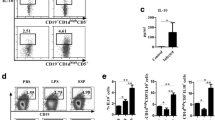Abstract
The small intestine is the initial organ which Toxocara canis larvae invade. Information on intestinal pathological changes associated with transforming growth factor-β1 (TGF-β1) and secretory granules (SG) in Paneth cells (PCs) caused by T. canis is unclear. Mice orally inoculated with 250 T. canis infective eggs were evaluated by pathological and immunohistochemical assessments with a 294-day investigation. Pathologically, the inflammatory reactions with or without trapped larvae in the submucosa were observed only within the first 28 days post-infection (DPI), with inflammatory injury ranging from severe during 2 DPI to mild between 7 and 28 DPI. The crypts of Leiberkuhn were major larval penetration sites. Enhanced expression of SG in PCs appeared earlier than those of TGF-β1 in infiltrating cells. The significance of both effectors might be related to the host’s defense against larval invasion in the intestinal phase of toxocaral infection.



Similar content being viewed by others
References
Abo-Shehada MN, Herbert IV (1984) The migration of larval Toxocara canis in mice. I. Migration through the intestine in primary infections. Vet Parasitol 17:65–73
Ayabe T, Satchell DP, Wilson CL, Parks WC, Selsted ME, Ouellette AJ (2000) Secretion of microbial α-defesins by intestinal Paneth cells in response to bacteria. Nat Immunol 1:113–118
Bevins CL, Martin-Porter E, Ganz T (1999) Defensins and innate host defense of the gastrointestinal tract. Gut 45:911–915
Blobe GC, Schiemann WP, Lodish HF (2000) Role of transforming growth factor beta in human disease. N Engl J Med 342:1350–1358
Bowman DD, Mika-Grieve M, Grieve RB (1987) Circulating excretory-secretory antigen levels and specific antibody responses in mice infected with Toxocara canis. Am J Trop Med Hyg 36:75–82
Cuellar C, Fenoy S, del-Aguila C, Guillen L (2001) Isotype-specific immune responses in murine experimental toxocariasis. Mem Inst Oswaldo Cruz 96:549–553
Epe C, Stabel T, Schnieder T, Stoye M (1994) The behavior and pathogenicity of Toxocara canis larvae in mice of different strains. Parasitol Res 80:691–695
Fan CK, Su KE, Chung WC, Tsai YJ, Chang MH, Lu JL, Chao PH (1998) A parasitological survey among stray dogs in Taipei City with hematological findings (in Chinese, with English abstract). J Chin Soc Vet Sci 24:288–294
Fan CK, Lin YH, Du WY, Su KE (2003) Infectivity and pathogenicity of 14-month-cultured embryonated eggs of Toxocara canis in mice. Vet Parasitol 113:145–155
Gomez-Escobar N, Lewis E, Maizels RM (1998) A novel member of the transforming growth factor-beta (TGF-beta) superfamily from the filarial nematodes Brugia malayi and B. pahangi. Exp Parasitol 88:200–209
Kamal M, Wakelin D, Ouellette AJ, Smith A, Podolsky DK, Mahida YR (2001) Mucosal T cells regulate Paneth and intermediate cell numbers in the small intestine of T. spiralis-infected mice. Clin Exp Immunol 126:117–125
Kerr-Muir MG (1994) Toxocara canis and human health. Br Med J 309:5-6
Lawrance IC, Maxwell L, Doe W (2001) Inflammation location, but not type, determines the increase in TGF-beta1 and IGF-1 expression and collagen deposition in IBD intestine. Inflamm Bowel Dis 7:16–26
Lewin K (1969) Histochemical observations on Paneth cells. J Anat 105:171–176
O’Lorcain P (1995) The effects of freezing on the viability of Toxocara canis and T. cati embryonated eggs. J Helminthol 69:169–171
Porter EM, Bevins CL, Ghosh D, Ganz T (2002) The multifaceted Paneth cell. Cell Mol Life Sci 59:156–170
Quellette AJ, Satchell DP, Hsieh MM, Hagen SJ, Selsted ME (2000) Characterization of luminal Paneth cell α-defesins in mouse small intestine. attenuated antimicrobial activities of peptides with truncated amino termini. J Biol Chem 275:33969-33973
Seno H, Sawada M, Fukuzawa H, Morita Y, Takaishi S, Hiai H, Chiba T (2001) Enhanced expression of transforming growth factor (TGF)-alpha precursor and TGF-beta1 during Paneth cell regeneration. Dig Dis Sci 6:1004–1010
Shull MM, Ormsby I, Kier AB, et al (1992) Targeted disruption of the mouse transforming growth factor-beta 1 gene results in multifocal inflammatory disease. Nature 359:693–699
Smith HV (1991) Immune evasion and immunopathology in Toxocara canis infection. In: Kennedy MW (ed) Parasitic nematodes: antigens, membranes and genes. CRC Press, London, pp 116–139
Wahl SM, McCartney-Francis N, Mergenhagen SE (1989) Inflammatory and immunomodulatory roles of TGF-beta. Immunol Today 10:258–261
Acknowledgements
The authors are grateful to Taipei Medical University for its support of this research (grants TMU-88-Y05-A106 and TMU-90-Y05-A142). We thank Mr. D.J. Kao and Mr. C.W. Liao for expert technical assistance; the Taipei Municipal Institute for Animal Health is acknowledged for providing experimental stray dogs from which adult Toxocara canis worms were collected. Also, Mr. D. Chamberlin is acknowledged for his critical revision of this paper.
Author information
Authors and Affiliations
Corresponding author
Rights and permissions
About this article
Cite this article
Fan, CK., Hung, CC., Lin, YH. et al. Enhanced expression of transforming growth factor-β1 in inflammatory cells and secretory granules in Paneth cells in the small intestine of mice infected with Toxocara canis. Parasitol Res 94, 397–404 (2004). https://doi.org/10.1007/s00436-004-1233-2
Received:
Accepted:
Published:
Issue Date:
DOI: https://doi.org/10.1007/s00436-004-1233-2




